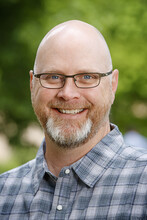Tiffany Lee, November 1, 2023
Husker team partnering with communities to enhance biodiversity education
Students who live in rural and tribal communities are surrounded by stunning examples of biodiversity: Grasses, prairies, flowers and wildlife feature more prominently in these youths’ lives compared to many of their peers in urban areas.
But systemic factors like geographic isolation, higher rates of poverty and limited educational resources sometimes minimize these students’ opportunities to explore and understand the natural environment surrounding them — and later pursue education and careers in the STEM fields.

A University of Nebraska–Lincoln team is partnering with communities across the Midwest and Southwest to begin filling these gaps. With a four-year, $1.2 million grant from the National Science Foundation, the team will develop models of informal biodiversity education for middle school youth in tribal and rural communities. By increasing local libraries’ biodiversity-related resources and strengthening youth STEM programming, the team aims to improve students’ analytical and problem-solving skills, enhance their classroom performance and strengthen their “science identity.”
A major goal is to pique these students’ interest in biodiversity and inspire them to eventually pursue STEM degrees and careers. Equally important, though, is helping members of these communities understand the importance of biodiversity — the full variety of species, genetic variabilities and ecosystems in the natural environment — and how human interventions in this web of life threaten the supply of clean water, food, medicine and protection against extreme weather.
Brad Barker, a 4-H science and technology specialist with Nebraska Extension, leads the interdisciplinary Husker team, which also includes Judy Diamond, University of Nebraska State Museum and University Libraries; Chad Brassil, College of Arts and Sciences; John Benson, School of Natural Resources; Michelle Krehbiel and Molly Brandt, Nebraska Extension; Gabriel Bruguier and Erica DeFrain, University Libraries; Aaron Sutherlen, Hixson-Lied College of Fine and Performing Arts; and Gwen Nugent, College of Education and Human Sciences.
At the heart of the project is the concept of co-creation. Barker said the team is focused on working collaboratively with local youth leaders to develop community-specific programs that are tailored to the needs of youth and their families.
“We are hoping to not only see how Western science approaches biodiversity, but also to learn about and incorporate Indigenous perspectives,” Barker said. “We’re trying to bring those together so there is one vision.”
Diamond echoed the importance of this fusion, particularly as scientists search for innovative and equitable strategies to reverse biodiversity loss.
“I think for everyone — the tribal communities and the non-tribal communities — the most exciting part of this project is how to integrate traditional Indigenous approaches to science with Western scientific approaches,” she said. “And how to build unity that strengthens both of those.”
The project will unfold in two phases. The first entails strengthening each of the library’s resources related to biodiversity education. Diamond, who has experience using NSF funding to strengthen local libraries, will lead partnerships with library staff, incorporating high-quality resources on biodiversity.
Showcasing Indigenous authors is a major priority and a key avenue for bolstering students’ ability to envision a pathway to college or a STEM career, said project consultant Judi gaiashkibos, executive director of the Nebraska Commission on Indian Affairs and a member of the Ponca Tribe.
“Young people can be inspired to pursue those career paths in STEM that aren’t, for a variety of reasons, approachable or believable to young people. But you have to see yourself in the books you’re reading,” she said. “That really is a deal-breaker: If you’re invisible in books, it’s hard to see the value of education.”
In the project’s second phase, the team will work with youth leaders to identify strategies for embedding biodiversity-related programming into existing youth groups. Brassil, a biodiversity researcher with extensive experience in youth science engagement, said one priority is teaching students the steps of scientific inquiry: observing, asking questions, forming hypotheses and designing experiments to uncover answers.
“This approach makes the student invested in the question and the answer, leading to lifelong change,” said Brassil, associate professor of biological sciences. “You own the answer. It’s more than just a one-hour experience.”
Toward this end, the team will tap into Barker’s extensive experience launching makerspaces in rural communities. Makerspaces — hubs of art and innovation that house cutting-edge equipment — will enable students to build resources, like a time-lapse camera, that could aid their experiments.
Barker said he ultimately hopes the team’s co-creation of informal STEM programming will serve as a model of partnership that other communities across the country can replicate.
Bruguier, assistant professor of University Libraries and a member of the Yankton Sioux Tribe, said the project represents a tremendous opportunity to look to the past in order to survive the future. Equipping rural and tribal students to become stewards of the environment — and perhaps the scientists of the future — is critical at a time when biodiversity loss is increasingly threatening human populations, with viable solutions in short supply.
“American Indians have been saying this for a long time: Our views accord with the way the world actually is,” he said. “You’re part of nature; you don’t try to conquer nature. That way of thinking has been with us for so long and promises to stay with us for much longer than the current way of thinking about the land as a commodity, which has led to the crisis we’re in now.”
College of Education and Human Sciences Hixson-Lied College of Fine and Performing Arts Nebraska Extension School of Natural Resources University Libraries University of Nebraska State Museum





